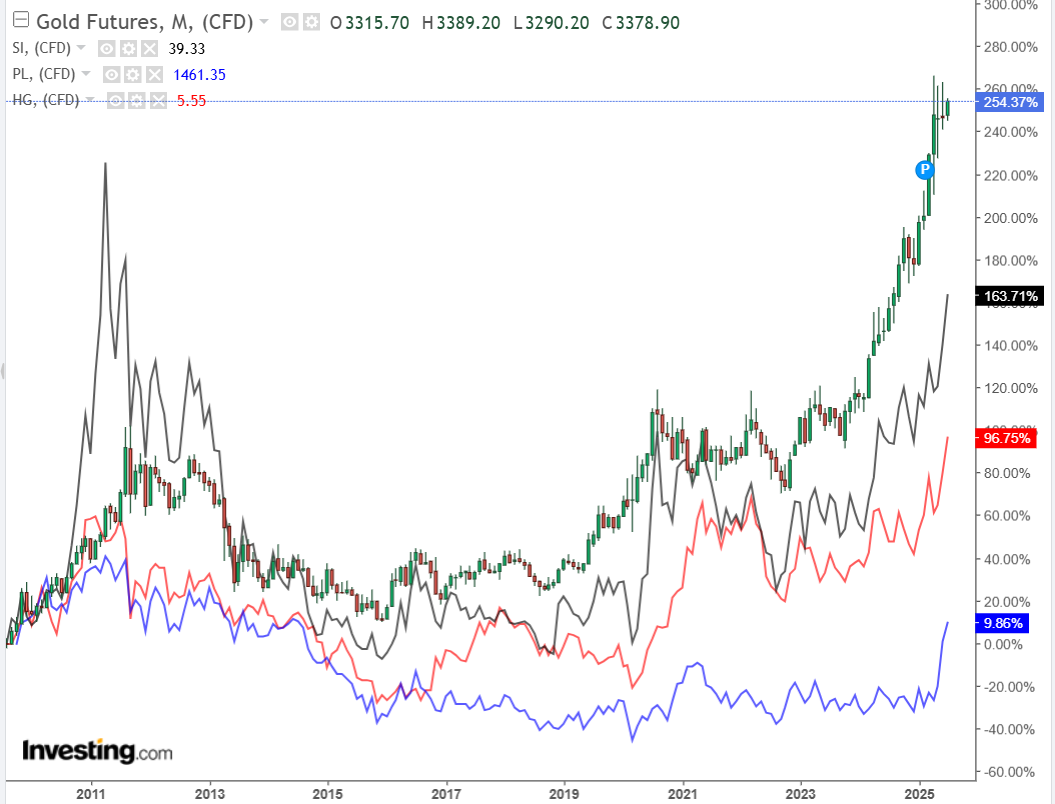Platinum: The Forgotten Metal With a Bullish Setup


Prices are up more than 50% year-to-date, but for platinum, that rally may only be the beginning. A combination of supply deficits, rising extraction costs, and growing interest from both retail and institutional investors suggests there’s still meaningful upside ahead.
Back in August 2024, we highlighted platinum’s favorable position relative to gold. At the time, this precious metal was trading around $950- an undervalued asset largely ignored by the markets. Fast forward to today, and the price is around $1,450, or more than 50% higher.
Since that article, we’ve received many questions from clients and readers:
Is now the time to buy? Should we hold? Or take profits?
Before answering that, let’s zoom out. The short-term rally is significant, but the long-term picture is even more revealing.
Platinum may be up sharply this year, but zoom out and it’s still the clear laggard – overlooked, underowned, and priced as if the last 15 years never happened.
A 15-Year Comparison
To provide proper context, we’ve compiled a 15-year chart of gold, silver, copper, and platinum, courtesy of Investing.com.
-
Gold: shown with candlesticks
-
Silver: black line
-
Copper: red line
-
Platinum: blue line
We’ve chosen to use spot prices rather than ETFs, as management fees would skew long-term performance. We also started the chart in 2010 to avoid the extreme volatility surrounding the 2008 financial crisis. In our opinion, most asset classes were reasonably priced again by 2010.
Here’s how the four metals have performed since then:
-
Gold: +254%
-
Silver: +163%
-
Copper: +96%
-
Platinum: +10%
Yes, platinum is still up just 10% since 2010, even after rallying more than 50% in 2025. For reference, the U.S. Consumer Price Index (CPI) was 217.965 in June 2010 and reached 321.465 in May 2025, representing a 47.5% increase. Gold is well ahead of inflation. Platinum hasn’t even kept pace with it.
Why the Underperformance?
There’s a reason platinum has lagged. Unlike gold, platinum has substantial industrial applications, particularly in the auto industry, where it is used in catalytic converters. That sector was severely impacted during the COVID-19 pandemic, with supply chain disruptions, reduced demand, and global production cuts.
Meanwhile, during 2020 and 2021, platinum production increased while demand remained subdued. This led to a buildup in inventory, a headwind for prices over the last few years.
What’s Changed?
Since then, the picture has shifted. Production has consistently lagged behind demand, and current forecasts anticipate the market will remain in deficit, with production running below consumption for the next several years.
But that’s just one piece of the puzzle.
What’s even more critical is the cost of extraction. Some analysts estimate that it now costs at least $1,300 per ounce to mine platinum, due to inflation in energy, labor, and regulatory costs. That means current prices may already be approaching breakeven levels, creating a strong support floor in pricing, even without speculative buying.
Platinum as a Store of Value
Still, the most interesting part of the platinum story is not industrial — it’s monetary.
Gold, which has almost no industrial use, has increased by more than 65% since the beginning of 2024 and is currently trading at around $3,350 per ounce. Yet platinum, the closest physical substitute to gold in terms of purity, scarcity, and use as a store of value, remains comparatively cheap.
In our view, platinum is a more efficient store of value than silver, as silver requires larger volumes for the same dollar value and is more expensive to store securely. Historically, central banks have been open to purchasing metals other than gold, including silver.
We believe central banks should begin to look at platinum as a reserve metal, not to replace gold, but to supplement gold holdings at a time when gold prices are at record highs and platinum remains fundamentally undervalued.
Platinum coins and bars are widely available, just like those in gold and silver, making the transition both practical and scalable.
A Case for Higher Prices
So what’s realistic?
Even after a 50% rally this year, we believe platinum remains undervalued. With strong retail demand, constrained supply, and rising production costs, the bullish case is compelling. If gold is trading at $3,350, we believe it’s entirely realistic for platinum to reach $2,000—a 35% increase from its current levels around $1,450.
And even then, platinum would only be matching inflation since 2010. In real terms, it would just be catching up to where it should have been all along.
What would the actual bull case look like?
Historically, platinum has traded at a premium to gold for extended periods. We’re not saying that will happen again, but in a small, thinly traded market, with increased monetary interest, it’s not unrealistic to think it could.
Final Thoughts
While the rally in 2025 has been strong so far, platinum remains undervalued in a broader historical and inflation-adjusted context. Supply constraints, rising production costs, and its overlooked potential as a monetary metal all support a higher price from here.
This isn’t just a speculative rebound – it’s a case of long-term mispricing finally starting to correct.
Is platinum in your portfolio? If not, is now the time to make a change?
Get the trading edge you need in today’s markets – sign up for our monthly newsletter featuring in-depth expert analysis, hot market insights, and exclusive trading strategies.

